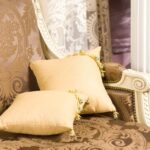Are you looking to add a personal touch to your home decor? One way to do so is by learning how to make decorative cushion covers at home. DIY cushion covers allow for creativity and customization, making your living space truly unique. In this article, we will guide you through the process of creating beautiful cushion covers that reflect your style and personality.
When it comes to making your own cushion covers, the materials needed are simple and readily available. From selecting the perfect fabric to choosing the right sewing techniques, we will provide you with all the information you need to get started on this fun and rewarding project. Whether you are a seasoned crafter or a beginner, making decorative cushion covers at home is an enjoyable way to enhance your living space.
Not only do DIY cushion covers give you the opportunity to showcase your creative side, but they also offer a budget-friendly alternative to store-bought options. By following our step-by-step instructions on choosing the right fabric, measuring and cutting accurately, and adding embellishments for that extra flair, you can create stunning cushion covers that will impress guests and bring a sense of coziness to your home.
Let’s embark on this crafting journey together and transform your living space with handmade decorative cushion covers.
Materials Needed
When it comes to making decorative cushion covers at home, one of the first steps is gathering the necessary materials. The key items you will need include fabric, thread, a sewing machine (which is optional but can make the process much faster), measuring tape, scissors, pins, and an iron. These basic supplies are essential for creating beautiful cushion covers that will add a personal touch to your home décor.
Choosing the Right Fabric
Selecting the right fabric for your DIY cushion covers is crucial to ensure both durability and style. Consider factors such as the texture of the fabric – whether you want something soft and cozy or more structured and sleek. Additionally, think about the overall look you are trying to achieve in your space. Fabrics like cotton, linen, or velvet are popular choices for cushion covers due to their versatility and durability.
Measuring and Cutting
To create perfectly fitting cushion covers, accurate measurements are key. Use your measuring tape to determine the dimensions of your cushions before cutting the fabric accordingly. Remember to account for seam allowances when cutting out your pieces. Precise cutting ensures a professional-looking finished product once you start sewing your decorative cushion covers together using various techniques like straight stitch or zigzag stitch.
Choosing the Right Fabric
When it comes to making decorative cushion covers at home, one of the most important aspects to consider is choosing the right fabric. The fabric you choose will not only determine the overall look of your cushions but also its durability and texture. Here are some tips on selecting the best fabric for your cushion covers based on these factors:
- Consider the location of your cushions: If you plan to use the cushions in a high-traffic area such as the living room, opt for durable fabrics like cotton canvas or twill that can withstand frequent use.
- Texture matters: The texture of the fabric can add depth and interest to your cushion covers. For a cozy and inviting feel, choose soft fabrics like velvet or chenille. If you prefer a more modern look, sleek fabrics like linen or silk work well.
- Match your style: Think about the overall style of your home decor when selecting fabric for your cushion covers. If you have a bohemian-inspired space, consider using colorful printed fabrics with intricate patterns. For a minimalist aesthetic, stick to solid colors in neutral tones.
By considering these tips on fabric selection, you can ensure that your DIY cushion covers not only look great but also stand the test of time in terms of both style and durability. Now that you’ve chosen the perfect fabric for your project, it’s time to move on to measuring and cutting to get started on creating custom cushion covers for your home.
Remember, when thinking about how to make decorative cushion covers at home, choosing the right fabric is key in achieving professional-looking results that reflect your personal style and taste.
Measuring and Cutting
Cutting the fabric for your decorative cushion covers is a crucial step in ensuring that they fit perfectly and look professionally made. To start, you will need to measure the dimensions of your cushion insert. Measure the width, length, and thickness of the cushion to determine the size of fabric needed. It’s important to add seam allowances to your measurements to account for sewing the pieces together.
Once you have your measurements, lay out your chosen fabric on a flat surface. Use a measuring tape and fabric chalk or pencil to mark the dimensions of your cushion cover on the wrong side of the fabric. Double-check your measurements before cutting to avoid any mistakes. Use sharp scissors to cut along the marked lines carefully.
For a clean finish, consider adding a half-inch seam allowance on all sides of your cushion cover pieces. This extra allowance will make it easier to sew and ensure that the cover fits snugly around the cushion insert. Taking time during this step will make a significant difference in the overall appearance and quality of your DIY decorative cushion covers.
| Aspect | Recommendation |
|---|---|
| Measurements | Add seam allowances for sewing |
| Cutting | Use sharp scissors for precise cuts |
| Seam Allowance | Add half-inch seam allowance for cleaner finish |
Sewing Techniques
When it comes to making decorative cushion covers at home, mastering different sewing techniques is essential to achieving professional-looking results. Whether you’re a novice or experienced seamstress, knowing how to use basic stitches like the straight stitch and zigzag stitch can make a big difference in the overall quality of your cushion covers. Here is a step-by-step guide on how to execute these sewing techniques effectively:
- Straight Stitch: The straight stitch is the most common and basic sewing stitch used in creating cushion covers. To achieve this stitch, simply set your sewing machine to a straight stitch setting. Place the fabric under the presser foot and align it with the edge of the fabric. Begin sewing slowly, backstitching at the beginning and end to secure the seam.
- Zigzag Stitch: The zigzag stitch is perfect for preventing fraying edges and adding stretchability to your cushion covers’ seams. Set your sewing machine to a zigzag stitch setting. Place the fabric under the presser foot, aligning it with the edge of the fabric. Sew along the edge using a zigzag motion to create a sturdy finish.
- Decorative Stitches: Adding decorative stitches can elevate the look of your cushion covers and make them unique. Experiment with different decorative stitches on your sewing machine, such as scallop stitches, leaf stitches, or floral stitches. These intricate designs can add a touch of elegance to your homemade cushion covers.
By mastering these essential sewing techniques – straight stitch, zigzag stitch, and decorative stitches – you can create beautiful and professionally finished cushion covers that will enhance your home decor.
Remember that practice makes perfect when it comes to sewing techniques. Don’t be afraid to experiment with different stitches and patterns to find what works best for your DIY cushion cover projects. With patience and creativity, you’ll soon become confident in creating stunning decorative cushion covers at home.
Adding Closure
When it comes to adding closure to your DIY decorative cushion covers, there are several options to choose from. One popular choice is the zipper closure, which provides a seamless and neat finish to your covers. To attach a zipper closure, measure the length of the opening on your cushion cover and sew the zipper along the edges using a zipper foot attachment on your sewing machine.
Another closure style is the envelope closure, which is not only functional but also adds a unique design element to your cushion covers. To create an envelope closure, cut one piece of fabric longer than the width of the cushion cover and fold over one edge twice before sewing it down. This will create an overlapping flap that allows you to easily insert and remove the cushion.
Lastly, button closures offer a classic and charming touch to your decorative cushion covers. To attach button closures, sew buttonholes on one side of the opening and sew buttons on the other side accordingly. This traditional closure style not only secures your cushion but also adds a delightful detail to your handmade covers.
For visual learners needing additional help with this topic, you can check out online tutorials or videos that provide step-by-step instructions on how to make decorative cushion covers at home with various closure styles like zippers, envelopes or buttons. Embrace your creativity by experimenting with different closure styles to find what works best for you and complements your home decor.
| Option | Description |
|---|---|
| Zipper Closure | A seamless finish that provides easy removal and insertion of cushions. |
| Envelope Closure | A unique design element that allows for quick access while keeping cushions secured. |
| Button Closure | A classic touch that adds charm and detail while securing cushions in place. |
Embellishments and Decorative Touches
One of the most rewarding aspects of making your own decorative cushion covers at home is the opportunity to add personal touches and creative flair to each piece. Embellishing your cushion covers with trims, piping, tassels, or embroidery can take them from plain to fabulous in just a few simple steps. Adding these decorative touches not only enhances the overall look of the cushions but also allows you to showcase your unique style and personality.
Trims are a versatile way to add texture and visual interest to your cushion covers. You can choose from a wide variety of trims such as pom-poms, fringe, ruffles, or lace to suit your aesthetic preferences.
Simply attach the trim along the edges of the cushion cover using a straight stitch on your sewing machine or hand-sew it for a more delicate touch. Trims can instantly elevate the look of your cushions, making them stand out as stylish statement pieces in any room.
Piping is another popular option for adding a professional and polished finish to your cushion covers. You can create custom piping by cutting fabric strips on the bias and wrapping them around cord before sewing them onto the edges of your covers. Piping not only adds structure and definition to the seams but also provides a subtle contrast that highlights the shape of the cushions.
Experiment with different colors and fabrics for piping to see how they can transform the overall design of your cushion covers. Remember, creativity knows no bounds when it comes to making decorative cushion covers at home.
Care and Maintenance
Regular Cleaning
To ensure that your handmade cushion covers last for years to come, it’s important to establish a regular cleaning routine. Depending on the fabric you chose, some cushion covers may be machine washable while others might require dry cleaning. Make sure to read the care instructions for the fabric and follow them accordingly. For machine washable covers, use a gentle cycle and mild detergent to avoid damaging the fabric.
Storage
Proper storage of your decorative cushion covers is essential to maintaining their quality and prolonging their lifespan. When not in use, store your cushion covers in a cool, dry place away from direct sunlight to prevent fading. Avoid stuffing them in tight spaces or folding them repeatedly as this can cause creases and damage the fabric over time. Consider using breathable storage bags or containers to protect your cushion covers from dust and moisture.
Repair and Maintenance
Even with proper care, wear and tear may eventually occur on your handmade cushion covers. To ensure they continue looking their best, make sure to inspect them regularly for any loose seams, missing buttons, or frayed edges. Repair any damages promptly by re-stitching seams, replacing buttons, or adding reinforcements where needed.
Additionally, consider rotating your cushion covers periodically to distribute usage evenly and prevent excessive wear on one side. Regular maintenance will help keep your decorative cushion covers looking fresh and vibrant for years to come.
Conclusion
In conclusion, DIY cushion covers are a wonderful way to add a personal touch to your home decor while also showcasing your creativity and style. By following the step-by-step guide outlined in this article on how to make decorative cushion covers at home, you can easily customize your living space with unique and beautiful pieces that reflect your taste.
When it comes to creating your own cushion covers, selecting the right fabric is crucial. Consider factors such as durability, texture, and style to ensure that the fabric not only looks good but also withstands daily use. Additionally, mastering basic sewing techniques like straight stitch, zigzag stitch, and decorative stitches will allow you to create professionally finished cushion covers that will impress anyone who sees them.
Don’t be afraid to experiment with different closure styles, embellishments, and decorative touches when making your cushion covers. Whether you prefer a classic zipper closure or want to add a pop of personality with tassels or embroidery, the possibilities are endless.
Lastly, remember to care for and maintain your handmade creations properly to make sure they remain in pristine condition for years to come. So grab your materials, unleash your inner designer, and start making beautiful decorative cushion covers for your home today.
Frequently Asked Questions
How Do You Make Decorative Pillow Covers?
Making decorative pillow covers can be a fun and creative project. One way to make them is by selecting a fabric of your choice, measuring and cutting it to fit the size of your pillow insert, and sewing the pieces together with a sewing machine or by hand.
Adding embellishments like buttons, fringe, or embroidery can add extra flair to your pillow covers.
What Kind of Fabric Do You Use for Cushion Covers?
When choosing fabric for cushion covers, it’s important to consider both durability and aesthetics. Fabrics like cotton, linen, polyester blends, or upholstery fabrics are commonly used for cushion covers due to their strength and ability to withstand wear and tear. Additionally, considering the color and texture of the fabric is crucial in complementing the overall decor of the space.
Is It Hard to Make Cushion Covers?
Making cushion covers doesn’t have to be difficult if you have basic sewing skills or are willing to learn. With simple rectangular cushion covers, all you need is fabric, a sewing machine (or needle and thread), measuring tape, pins, and scissors.
Following step-by-step instructions or watching tutorials can help guide you through the process of making cushion covers. Practice makes perfect!

I’m thrilled to be your companion on this exciting journey through the world of home decor and design. With a passion for turning houses into homes and a keen eye for the finer details, I’m here to help you transform your living spaces into beautiful, functional, and meaningful havens.





